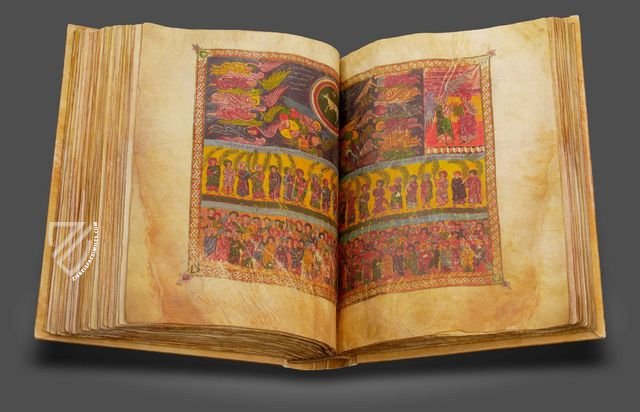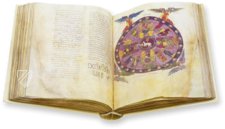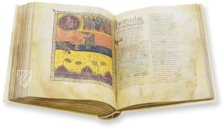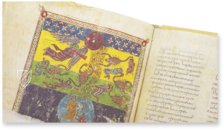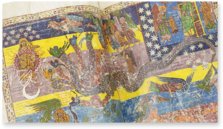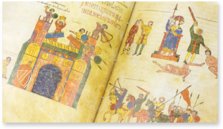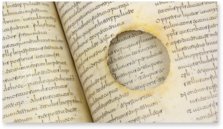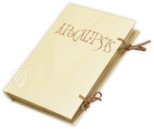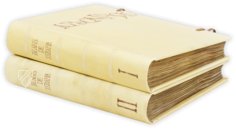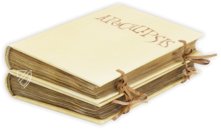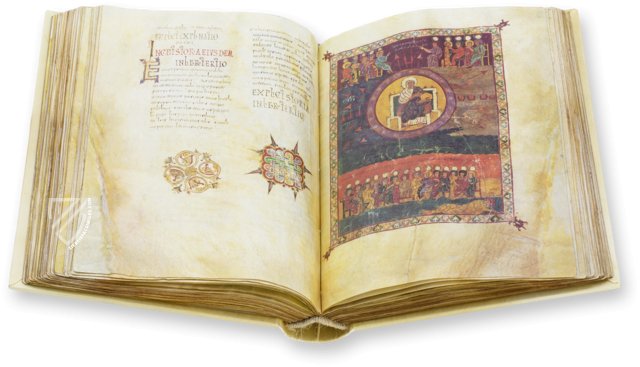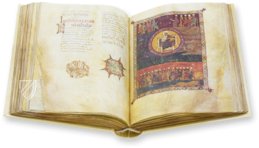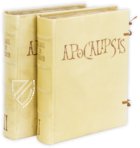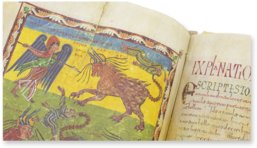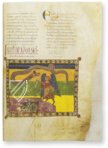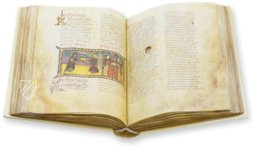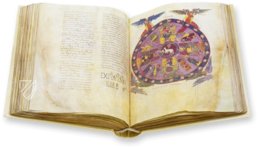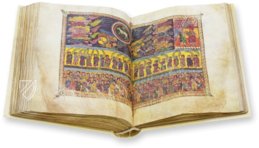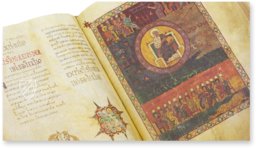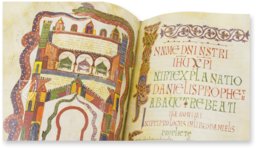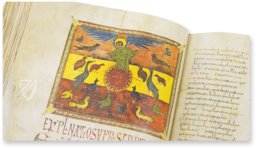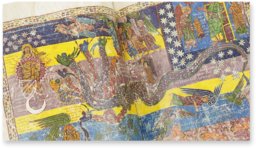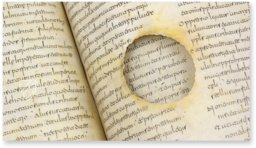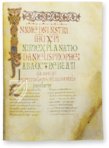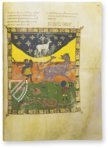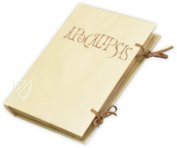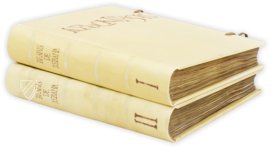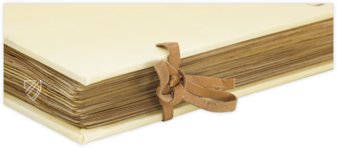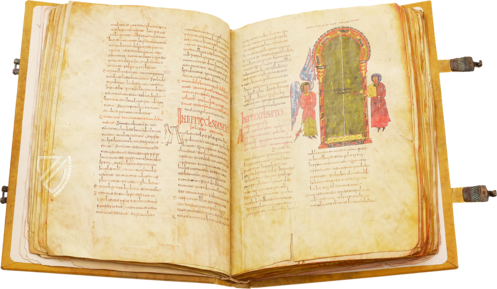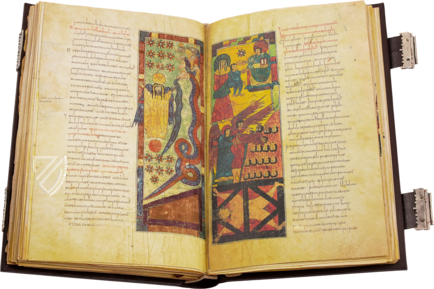Beatus of Liébana - San Miguel de Escalada Codex
(7,000€ - 10,000€)
The first illustrated manuscript of the famous Apocalypse commentary of Beatus of Liébana set standards that influenced two centuries of artists thereafter. The so-called Beatus of San Miguel de Escalda Codex or Morgan Beatus (after its present repository, the Morgan Library in New York), originated in the middle of the 10th century as a commission for Abbot Victor of the San Miguel de Escalada Abbey. The scribe and master of the 131 miniatures, which he immortalized himself in his famous work, bore the name of Maius. He was active in the famous scriptorium of San Salvador de Tábara. In the Morgan Beatus, Maius expressed his impressive mastery, in both high artistic quality as well as innovative pictorial invention. The manuscript with innovative elements for the illustration of the Apocalypse commentary of Beatus of Liébana stands at the beginning of a long and one of the most important traditions of northern Spanish illumination.
Beatus of Liébana - San Miguel de Escalada Codex
The first illustrated manuscript of the famous Apocalypse commentary of Beatus of Liébana set standards that influenced two centuries of artists thereafter. The so-called Beatus of San Miguel de Escalda Codex or Morgan Beatus (after its present repository, the Morgan Library in New York), originated in the mid–10th century as a commission for Abbot Victor of the San Miguel de Escalada Abbey. The scribe and master of the 131 miniatures, which he immortalized himself in his famous work, bore the name of Maius. He was active in the famous scriptorium of San Salvador de Tábara. In the Morgan Beatus, Maius expressed his impressive mastery, in both high artistic quality as well as innovative pictorial invention. The manuscript with innovative elements for the illustration of the Apocalypse commentary of Beatus of Liébana stands at the beginning of a long and one of the most important traditions of northern Spanish illumination.
The Master from Tábara
In the so-called Tábara Beatus (not to be confused with the Morgan Beatus), there is a famous depiction of the famous scriptorium of Tábara in a tower. In that very tower-scriptorium in San Salvador de Tábara, worked the masterful scribe and miniaturist Maius (926–968), who is also buried in Tábara. It was he who completed a pioneering, splendidly illuminated Beatus manuscript in years ca. 940–945. The San Miguel de Escalada Codex, divided today into two volumes, contains a colophon, in which Maius states his names and that of his commissioner, the place of origin, and the year of its creation. This precious detail allows us a wonderful glimpse into the circumstances of the creation of such a valuable manuscript.
The Eventful Ownership History
Its eventful provenance also makes the significance of the Morgan Beatus clear. Abbot Victor of San Miguel de Escalada is named as the original commissioner. From there the manuscript began a long voyage before it reached is present day repository. So it was, among others, in the possession of the Archbishop of Valencia in the 16th century and came into the possession of an Italian collector in the 19th century. Thereafter the Beatus of San Miguel de Escalada was acquired by an Earl of Ashburnham, later belonged to Henry Yates Thompson, and finally found its way into the possession of J.P. Morgan in 1919, still constituting one of the treasures of his valuable library collection in New York today.
The First Beatus
As the oldest complete manuscript of the Apocalypse commentary of Beatus of Liébana, the Morgan Beatus stands at the beginning of a long tradition The famous Apocalypse commentary, which arose in 776 and consisted of 12 books, by the Asturian monk and theologian Beatus of Liébana was a chief subject of illumination in Spain from the 10th to the 12th centuries. The often terrifying and altogether fantastical pictures of the end of the world from the Book of Revelation offered the miniaturists the opportunity to give full scope to their fantasy and to add their fantasies away from reality.
Masterful, Pioneering Representations
The miniaturist Maius was the first to illustrate the complete text by Beatus of Liébana. With his miniatures, the master from Tábara set a new standard. He created pioneering pictorial subjects that were supposedly adopted and refined in the following centuries by numerous miniaturists. Impressive scenes play out before a brightly colored background, which with its arrangement of yellow, green, and red color stripes give rise to an unreal, eschatological world. The miniatures are bordered by gorgeous, ornamentally designed frames. Depictions of the heavenly Jerusalem, the adoration of the lamb, or the angels blowing the trumpets of the Apocalypse indicate the innovative reinventions of pictorial adornment alongside their “exceptional artistic quality” in particular. In the manuscript, Maius also names his motives: he wants to elucidate the terror of the coming Day of Judgement. He achieved this goal with a supreme performance. His illustrations of the Apocalypse commentary of Beatus of Liébana are still able to captivate the beholder today with luminous colors, artful forms, and fantastical content.
Codicology
- Alternative Titles
- Beatus von Liébana - Codex San Miguel de Escalada
Apocalipsis de San Juan. Beato de Liebana. San Miguel de Escalada
Morgan Beatus
Ashburnham-Morgan Beatus
Beatus of Liébana - Morgan Codex - Size / Format
- 2 volumes - 606 pages / 38.7 × 28.5 cm
- Origin
- Spain
- Date
- Ca. 940–945
- Epochs
- Style
- Genre
- Language
- Illustrations
- 131 partly double and full page miniatures
- Patron
- Abbot Victor of the Monastery of San Miguel de Escalada
- Artist / School
- Beatus of Liébana (died after 798) (author)
Maius (926–968) (scribe and illuminator) - Previous Owners
- Martín Perez de Ayala, Archbishop of Valencia
Order of Saint James in Uclés
Roberto Frasineli
Francisque Michel
Guglielmo Libri
Bertram, 4th Earl of Ashburnham
Henry Yates Thompson
Beatus of Liébana - San Miguel de Escalada Codex
Nebuchadnezzar
Some Beatus manuscripts included scenes from the Old Testament that foretold events in Revelation. King Nebuchadnezzar II of Babylon sacked Jerusalem in 587 BC and destroyed the First Temple – a divine punishment according to Ezekial. Nebuchadnezzar holds a spear and a scroll while Zedekiah, the deposed king of Judah, is dressed in red: “Then they killed the sons of Zedekiah before his eyes, put out the eyes of Zedekiah, bound him with bronze fetters, and took him to Babylon.” (2 Kgs. 25:7)
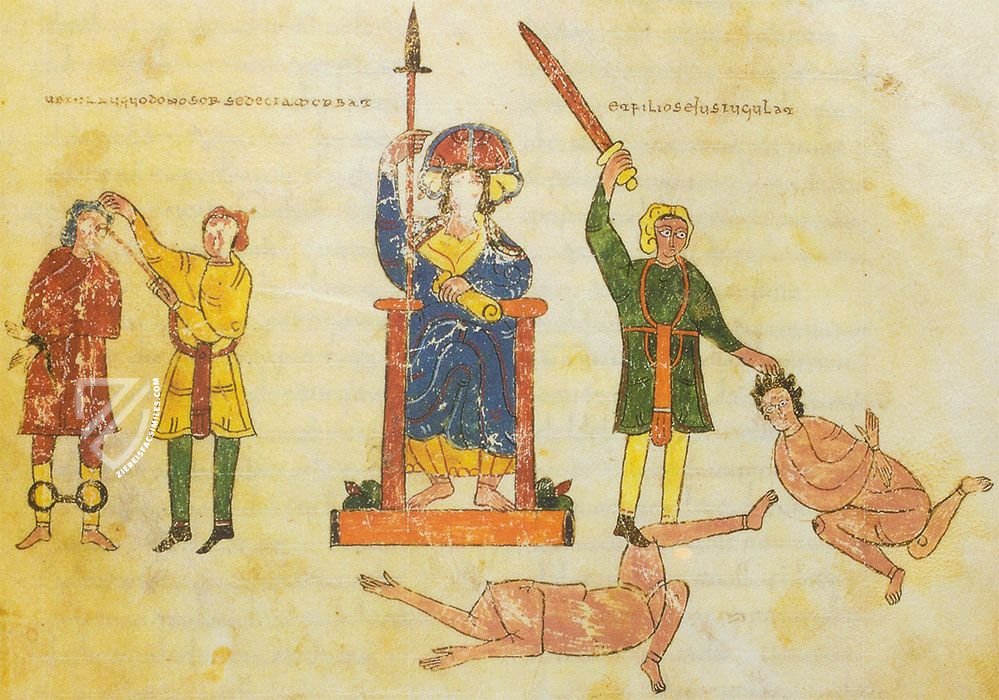
Beatus of Liébana - San Miguel de Escalada Codex
The Victory of the Lamb over the Kings
This is one of the oldest surviving Beatus manuscripts, which was style-setting for the genre. This is especially true with regard to the color scheme of mixing deep, dark colors with bold, bright ones. This color scheme often served to differentiate between the astral planes.
“These shall make war with the Lamb, and the Lamb shall overcome them: for he is Lord of lords, and King of kings: and they that are with him are called, and chosen, and faithful.” (Rev. 17:14). The Lamb of God watches the events on earth as the faithful, identified by their halos, triumph over the wicked, whose decapitated naked bodies indicate that they are hell-bound. The beast and serpent, their eyes filled with dismay, appear as though they are fleeing the carnage.

#1 Apocalipsis de San Juan. Beato de Liebana. San Miguel de Escalada
Languages: English, Spanish
(7,000€ - 10,000€)
- Treatises / Secular Books
- Apocalypses / Beatus
- Astronomy / Astrology
- Bestiaries
- Bibles / Gospels
- Chronicles / History / Law
- Geography / Maps
- Saints' Lives
- Islam / Oriental
- Judaism / Hebrew
- Single Leaf Collections
- Leonardo da Vinci
- Literature / Poetry
- Liturgical Manuscripts
- Medicine / Botany / Alchemy
- Music
- Mythology / Prophecies
- Psalters
- Other Religious Books
- Games / Hunting
- Private Devotion Books
- Other Genres
- Afghanistan
- Armenia
- Austria
- Belgium
- Colombia
- Croatia
- Cyprus
- Czech Republic
- Denmark
- Egypt
- Ethiopia
- France
- Germany
- Greece
- Hungary
- India
- Iran
- Iraq
- Israel
- Italy
- Japan
- Lebanon
- Luxembourg
- Mexico
- Morocco
- Netherlands
- Palestine
- Peru
- Poland
- Portugal
- Russia
- Serbia
- Spain
- Sri Lanka
- Sweden
- Switzerland
- Syria
- Turkey
- Ukraine
- United Kingdom
- United States
- Uzbekistan
- Aboca Museum
- Ajuntament de Valencia
- Akademie Verlag
- Akademische Druck- u. Verlagsanstalt (ADEVA)
- Aldo Ausilio Editore - Bottega d’Erasmo
- Alecto Historical Editions
- Alkuin Verlag
- Almqvist & Wiksell
- Amilcare Pizzi
- Andreas & Andreas Verlagsbuchhandlung
- Archa 90
- Archiv Verlag
- Archivi Edizioni
- Arnold Verlag
- ARS
- Ars Magna
- ArtCodex
- AyN Ediciones
- Azimuth Editions
- Badenia Verlag
- Bärenreiter-Verlag
- Belser Verlag
- Belser Verlag / WK Wertkontor
- Benziger Verlag
- Bernardinum Wydawnictwo
- BiblioGemma
- Biblioteca Apostolica Vaticana (Vaticanstadt, Vaticanstadt)
- Bibliotheca Palatina Faksimile Verlag
- Bibliotheca Rara
- Boydell & Brewer
- Bramante Edizioni
- Bredius Genootschap
- Brepols Publishers
- British Library
- C. Weckesser
- Caixa Catalunya
- Canesi
- CAPSA, Ars Scriptoria
- Caratzas Brothers, Publishers
- Carus Verlag
- Casamassima Libri
- Chavane Verlag
- Christian Brandstätter Verlag
- Circulo Cientifico
- Club Bibliófilo Versol
- Club du Livre
- CM Editores
- Collegium Graphicum
- Collezione Apocrifa Da Vinci
- Comissão Nacional para as Comemorações dos Descobrimentos Portugueses
- Coron Verlag
- Corvina
- CTHS
- D. S. Brewer
- Damon
- De Agostini/UTET
- De Nederlandsche Boekhandel
- De Schutter
- Deuschle & Stemmle
- Deutscher Verlag für Kunstwissenschaft
- DIAMM
- Droz
- E. Schreiber Graphische Kunstanstalten
- Ediciones Boreal
- Ediciones Grial
- Ediclube
- Edições Inapa
- Edilan
- Editalia
- Edition Deuschle
- Edition Georg Popp
- Edition Leipzig
- Edition Libri Illustri
- Editiones Reales Sitios S. L.
- Éditions de l'Oiseau Lyre
- Editions Medicina Rara
- Editorial Casariego
- Editorial Mintzoa
- Editrice Antenore
- Editrice Velar
- Edizioni Edison
- Egeria, S.L.
- Eikon Editores
- Electa
- Emery Walker Limited
- Enciclopèdia Catalana
- Eos-Verlag
- Ephesus Publishing
- Ernst Battenberg
- Eugrammia Press
- Extraordinary Editions
- Fackelverlag
- Facsimila Art & Edition
- Facsimile Editions Ltd.
- Facsimilia Art & Edition Ebert KG
- Faksimile Verlag
- Feuermann Verlag
- Folger Shakespeare Library
- Franco Cosimo Panini Editore
- Friedrich Wittig Verlag
- Fundación Hullera Vasco-Leonesa
- G. Braziller
- Gabriele Mazzotta Editore
- Gebr. Mann Verlag
- Gesellschaft für graphische Industrie
- Getty Research Institute
- Giovanni Domenico de Rossi
- Giunti Editore
- Graffiti
- Grafica European Center of Fine Arts
- Guido Pressler
- Guillermo Blazquez
- Gustav Kiepenheuer
- H. N. Abrams
- Harrassowitz
- Helikon
- Hendrickson Publishers
- Henning Oppermann
- Herder Verlag
- Hes & De Graaf Publishers
- Hoepli
- Holbein-Verlag
- Hortus Deliciarum
- Houghton Library
- Hugo Schmidt Verlag
- Idion Verlag
- Il Bulino, edizioni d'arte
- ILte
- Imago
- Insel Verlag
- Instituto Nacional de Antropología e Historia
- Istituto dell'Enciclopedia Italiana - Treccani
- Istituto Ellenico di Studi Bizantini e Postbizantini
- Istituto Geografico De Agostini
- Istituto Poligrafico e Zecca dello Stato
- Italarte Art Establishments
- J. Thorbecke
- Jan Thorbecke Verlag
- Johnson Reprint Corporation
- Josef Stocker
- Josef Stocker-Schmid
- Jugoslavija
- Karl W. Hiersemann
- Kasper Straube
- Kaydeda Ediciones
- Kindler Verlag / Coron Verlag
- Kodansha International Ltd.
- Konrad Kölbl Verlag
- Kurt Wolff Verlag
- La Liberia dello Stato
- La Linea Editrice
- La Meta Editore
- Lambert Schneider
- Landeskreditbank Baden-Württemberg
- Leo S. Olschki
- Les Incunables
- Library of Congress
- Libreria Musicale Italiana
- Lichtdruck
- Lito Immagine Editore
- Lumen Artis
- Lund Humphries
- M. Moleiro Editor
- Maison des Sciences de l'homme et de la société de Poitiers
- Manuscriptum
- Martinus Nijhoff
- Maruzen-Yushodo Co. Ltd.
- MASA
- McGraw-Hill
- Militos
- Millennium Liber
- Müller & Schindler
- Nahar and Steimatzky
- National Library of Wales
- Neri Pozza
- Nova Charta
- Oceanum Verlag
- Odeon
- Orbis Mediaevalis
- Orbis Pictus
- Österreichische Staatsdruckerei
- Oxford University Press
- Pageant Books
- Parzellers Buchverlag
- Patrimonio Ediciones
- Pattloch Verlag
- PIAF
- Pieper Verlag
- Plon-Nourrit et cie
- Prestel Verlag
- Princeton University Press
- Prisma Verlag
- Priuli & Verlucca, editori
- Pro Sport Verlag
- Propyläen Verlag
- Pytheas Books
- Quaternio Verlag Luzern
- Reales Sitios
- Recht-Verlag
- Reichert Verlag
- Reichsdruckerei
- Riehn & Reusch
- Roberto Vattori Editore
- Rosenkilde and Bagger
- Roxburghe Club
- Salerno Editrice
- Sarajevo Svjetlost
- Schöck ArtPrint Kft.
- Scolar Press
- Scrinium
- Scripta Maneant
- Scriptorium
- Siloé, arte y bibliofilia
- SISMEL - Edizioni del Galluzzo
- Sociedad Mexicana de Antropología
- Société des Bibliophiles & Iconophiles de Belgique
- Soncin Publishing
- Sorli Ediciones
- Stainer and Bell
- Studer
- Styria Verlag
- Sumptibus Pragopress
- Szegedi Tudomànyegyetem
- Taberna Libraria
- Tarshish Books
- Taschen
- Tempus Libri
- Testimonio Compañía Editorial
- Thames and Hudson
- The Clear Vue Publishing Partnership Limited
- The Facsimile Codex
- The Folio Society
- The Marquess of Normanby
- The Richard III and Yorkist History Trust
- Tip.Le.Co
- TouchArt
- TREC Publishing House
- TRI Publishing Co.
- Trident Editore
- Typis Regiae Officinae Polygraphicae
- Union Verlag Berlin
- Universidad de Granada
- University of California Press
- University of Chicago Press
- Urs Graf
- Vallecchi
- Van Wijnen
- VCH, Acta Humaniora
- VDI Verlag
- VEB Deutscher Verlag für Musik
- Verlag Anton Pustet / Andreas Verlag
- Verlag Bibliophile Drucke Josef Stocker
- Verlag der Münchner Drucke
- Verlag für Regionalgeschichte
- Verlag Styria
- Vicent Garcia Editores
- W. Turnowsky
- Waanders Printers
- Wiener Mechitharisten-Congregation (Wien, Österreich)
- Wissenschaftliche Buchgesellschaft
- Wydawnictwo Dolnoslaskie
- Xuntanza Editorial
- Zakład Narodowy
- Zollikofer AG

